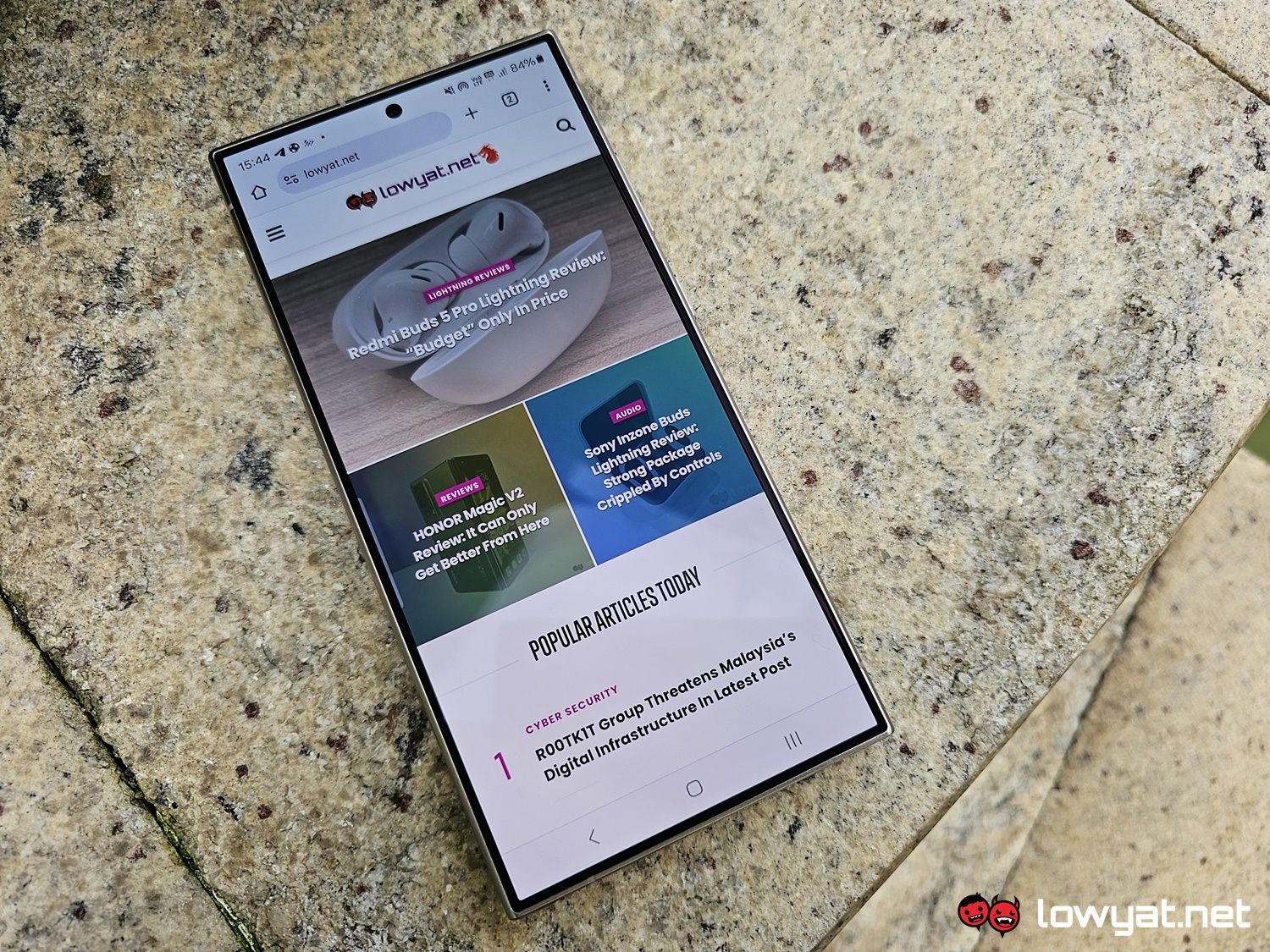We’re almost a month into 2024 and as evidenced by its recent Unpacked, Samsung is wasting no time in hyping up the soon-to-be available Galaxy S24 Series. In this review, I’ll be going through the brand’s flagship of the series, the S24 Ultra, along with the key differences that it offers over its predecessor, major and minor.
Specification
Looks And Functionality
You’re going to hear me say this a few times throughout this review, in one form or another: Like the S23 Ultra, the S24 Ultra maintains the status quo with its looks in general, save for some obvious and not-so-obvious changes, both internally and cosmetically. One thing is for certain, Titanium is a major theme with the model and only this model of the series. By that, I mean that Titanium isn’t just a suggestion: it’s the phone’s identity, regardless of the colourways that Samsung is offering with them.
On the aesthetic side of things, there are definitely some changes, assuming you’re anal-retentive and detail-oriented enough to pay close enough attention to it. For starters, while the screen remains the same size as its predecessor at 6.8-inches, it has a bigger screen-to-body ratio. So, as I mentioned in my hands on, you’re not going to be able to reuse that nice, custom casing from your S23 Ultra with this phone.
The second change to the display of the S24 Ultra that you’ll notice is the curves on the edges or lack thereof. While I am impartial to the change of display type, I know one of my colleagues would be jumping for joy over the re-adoption of the non-curved panel. That said, it’s still the same Dynamic AMOLED 2X technology, along with the 120Hz refresh rate and HDR10+ support, only this year, Samsung is introducing an LTPO panel. Oh, and it’s Corning Gorilla Glass Armor now, which is a step above the previous Victus 2 iteration, meaning that it is more durable than the last.
One benefit to the new display of the S24 Ultra is that, in my hands, my grip feels a lot firmer with it than with the S23 Ultra. On that note, the titanium chassis of this phone provides that that little ounce of assurance that the phone is able to withstand any knocks, scuffs, and drops. Not that I would recommend any of you to actively drop-test your phone on any hard surface. Perish the thought.
Other cosmetic changes include the smaller 10MP and sensor modules being raised and reinforced with metal rings, much in the same way as the triple-camera modules. Oh, and the bottom speaker is now one single slit, instead of a grille, and while we’re looking at the bottom of the phone, you get the usual USB-C port that supports 45W fast-charging and UFS 4.0 transfer rates, the latter being useful whenever I want to transfer files manually.
Lastly, we can’t talk about the S24 Ultra without mentioning the S Pen, to which the accessory is also enveloped by the same Titanium motif.
Performance And Battery
When Qualcomm boasted that the Snapdragon 8 Gen 3 would provide a significant boost in performance, it wasn’t kidding. Just by general use of the S24 Ultra – scrolling through sites and my newsfeed, to searching and downloading apps, you can see how much more responsive these little actions are. And this is despite the Snapdragon 8 Gen 2 still being one helluva SoC. Then as now, windows transition seamlessly, and apps snap open with virtually no delay to them.
Synthetically, the 8 Gen 3 inside the S24 Ultra performs every bit as you’d expect from the chipset. It makes short work of any test that is thrown at it, even maxing out the Wild Life test for UL’s 3DMark.
Galaxy AI’s active translation is fantastic but the function is wholly dependent on the tools and assets provided by Samsung. In other words, if the language isn’t on the Galaxy AI list of 17 languages that includes a translation for the Indian version of English, you’re unfortunately going to have to manually copy the text you want translated and paste it in Google Translate.
Likewise, the active Text Translation feature is not just at the mercy of the current 17 translated limit, but the number of messaging apps that can take advantage of the function is also limited. At the time of writing, WhatsApp is the only 3rd party app that benefits from it. Yeap, not even Telegram or Facebook Messenger makes the list.

There is also the Text-to-Speech translation, yet another Galaxy AI feature that actually works very well. So far, the non-English languages that the features translate over the S24 Ultra for me is Malay and Mandarin, with approximately 95% accuracy. I give that aggregate because the function isn’t quite able to understand certain slang, particularly with Malay.
Moving on, battery life on the S24 Ultra is astoundingly long, with the phone giving me more than two and a half days of juice when used as my daily driver, including checking my mail, responding to messages, and the occasional video on YouTube or Netflix, while in transit. On a straight out binge, though, the phone gives approximately 10 hours of continuous use with brightness set at 40%.

This is an interesting finding because, according to my colleague’s testing with the base S24 model, he claims more 25 hours of continuous video use, while my colleague using the S24+ says he gets 16 hours on average.
Camera
Now, it should be noted that compared to the S23 Ultra, the main camera on the S24 Ultra feels like a downgrade and, to some measurable degree, you’d be right in feeling that way. Technically speaking, the camera has been given a slight bump up with one of its modules, from 10MP to 50MP. That’s the sensor that provides 5x Optical Zoom and 10X Optical Quality Zoom. Note that Samsung is marketing the last part as “Optical Quality” and not true Optical Zoom. By comparison, the 10MP sensor on the S23 Ultra was able to capture images taken at 10x Optical Zoom.
Besides that, you still get the same 200MP main wide sensor that now provides a 2x “Optical Quality” zoom function, along with the 12MP ultrawide, 10MP periscope telephoto sensor with its 3X Optical Zoom, and the TOF sensor. At this stage, you’re probably wondering how overall photography of the S24 Ultra is compared to the S23 Ultra and honestly, the differences and quality degradation is minimal, at best. Images still retains an astounding level of detail and if you’re shooting in portrait mode, the software is still brilliant enough at making sure that the final image just the right amount of bokeh.
On a sidebar, I know my gallery doesn’t have any low-light or night time photography for the time being, but that’ll be added on at a later date after the publication of this review.
Of course, given that this is an S24 Ultra, I can’t run away from talking about the “benefits” of Galaxy AI on the camera. Firstly, you get a much improved “highlight and search” function from Google, at least in small measure; if you’re translating a foreign language, highlighting the text with my finger automatically gives me the final translation. Do the same with an image, either by highlighting or circling the subject, and it doesn’t always come back with the exact or accurate answer. For example, when asking it to identify something as generic as a jacket, no matter the actual branding, it starts showing me similar knock-offs, along with their price on Lazada and Shopee.
Then there is Generative Edit. If I’m being honest, it’s a feature that functions a lot like medicine: it works in small doses, and at a literal glance, you’re not going to notice what’s the Galaxy AI has done. Now, to be clear, this isn’t me saying that the way it works horribly on the S24 Ultra in any measure but rather, it is a feature that is working with the information and environment it has in that moment, and as such, still has some ways to go before it can reach what I would describe as shadow government-level photo editing.
Sample Images
Competition
Samsung Galaxy S23 Ultra
Yes, it is effectively previous gen at this stage but as it stands, the S23 Ultra still stands its ground as a worthy competitor to the S24 Ultra, the current lack of Galaxy AI notwithstanding. Again, the Snapdragon 8 Gen 2 SoC inside it is still a powerhouse, and that 200MP sensor in its main camera is equally as capable.
Also, if you’re planning on just getting this instead of the S24 Ultra, Samsung recently knocked down its price tag by RM400 for all storage configurations.
Apple iPhone 15 Pro Max

The alternative to 2024’s start-of-the-year flagship is undoubtedly Apple’s plus-sized iPhone 15 Pro Max. This phone rocks the 3nm A17 Pro SoC, has a 6.7-inch LTPO Super Retina XDR OLED panel with 120Hz refresh rate, up to 1TB of storage, and a triple-camera configuration comprising a 48MP main, a 12MP telephoto, and a 12MP ultrawide.
As for price, the phone starts at RM6,499 for the base 256GB model, while the top-specced 1TB model will set you back RM8,499.
Conclusion
At a starting price of RM6,299 and maximum price of RM8,499, the Samsung Galaxy S24 Ultra currently sits as one of the most expensive non-foldable devices that you can get yourself on the current market. If we’re honest, it doesn’t feel like a worthwhile purchase if you’re trading up from the S23 Ultra. In fact, I would actually recommend that you hold off for a generation and stick with the S23 Ultra, especially if you can and are willing to give the whole Galaxy AI a miss, for now.
On the subject of Galaxy AI, I’ve said this before and I’ll gladly say it again: at this stage, the feature feels more of a gimmick, a novelty, particularly when it comes to using it as a tool to erase certain subjects and objects from an otherwise perfect image. The good news to this, though, is that like all AI-driven tools and features, Galaxy AI is likely to improve in the long-run, so long as users of the Galaxy S24 Series and the S24 Ultra continuously contributes to its training and ultimately, making it better at regenerating and composing images.
Having said that, if you’re trading up from anything older than that, say the S22 Ultra or an S21 Ultra, then yes: this phone will most certainly be a big bump up in performance.
Follow us on Instagram, Facebook, Twitter or Telegram for more updates and breaking news.

























